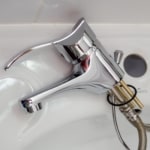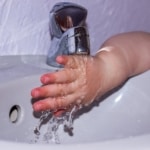Your Faucet Can No Longer Be Closed? (Causes & Solutions)
If your faucet can no longer be closed, you may face a serious challenge.
Not only does this increase your water bill significantly. A leaky or jammed fitting also indicates years of wear and tear, which can result in further damage.
In this article you will learn:
- why different types of fittings cause problems at some point when trying to close them
- which solutions there are and
- how you can prevent the problem in the long term
Contents
The faucet doesn’t close – common causes
If a faucet can no longer be closed, it is usually due to age.
The ravages of time take a toll on the moving parts of the faucet, especially with cheap models. This can lead to levers and handles jamming.
And limescale is also a common culprit, especially in households with hard water.
Of course, too violent a movement can also ensure that the faucet never moves again.
Attention: This problem should not be confused with the run-on/drip in low-pressure fittings, which is completely normal. Read more about that here.
First step: turn off the water
Before the search for the exact cause and the replacement can begin, the water supply must be interrupted.
For bathroom and kitchen fittings, this usually works via the corresponding corner valves under the sink in the kitchen or bathroom.
With other faucets, for example outside ones or those for washing machines, you should turn off the main shutoff valve. This is usually in the basement, directly after the water meter.
How you should proceed now depends on the exact type of fitting.
Faucets with screw caps
Classic screw-on faucets are rarely found in bathrooms and kitchens today.
However, they are still used as feed regulators for washing machines or water connections on the outside of the house.
Since they are rarely turned and are exposed to severe weather conditions, limescale and rust build up quite often.
Then it is only a matter of time before the spindle of the faucet gets stuck in the thread.
Solution 1: gentle hammering
As a first step, try tapping the body of the faucet gently with a small hammer while turning it.
In this way, the canting can possibly be solved. Be careful, however, so as not to damage the faucet or water pipe.
Solution 2: hot water
If tapping doesn’t work, you can try the following trick:
Wrap a rag with hot water around the base of the handle of the faucet. The material expands, which may free the thread again.
Solution 3: replace the upper part
If that doesn’t work either, the top of the faucet is probably so worn out that you should try to replace it.
Fortunately, this can easily be done without a plumber by following these steps:
- Turn off the water.
- Unscrew the upper part with an Allen key underneath the rotary handle. Have a bucket ready to catch any remaining water.
- Screw in the new top and tighten with a wrench.
Solution 4: clean the upper part
If the wear has not progressed too far, you can also try cleaning the upper part.
If traces of rust can be seen, we recommend spraying with a special WD-40 spray.
If, on the other hand, the thread is calcified, you should treat the upper part with vinegar or other household agents.
The faucet drips when it is closed – what to do?
If a faucet no longer holds back the water when it is closed, it is usually due to the seal.
To examine this, proceed as described above and look at the sealing ring on the valve of the upper part.
If it is already very porous, you should replace it with a new one. Here’s how that is done:
- Loosen the small nut at the end of the valve stem and pull off the old sealing ring.
- Use a cloth to remove dirt from the area under the sealing ring.
- Then install the new sealing ring and screw the nut tight, but not too tight yet.
- Center the sealing ring before tightening the nut firmly. The ring should no longer have any freedom of movement.
Caution: If the water does not come out of the faucet but in the area of the rotary handle, the so-called stuffing box is probably porous.
Two-handle fittings
If your two-handle faucet drips when closed, one of the handles is likely to blame. You can determine which it is as follows:
First close the corner valve for cold water. If no more water comes out, the problem is with the cold water handle. If the water continues to drip, the problem is with the other handle.
First, you can carefully tap the handle in different opening positions with a hammer and a piece of wood as a base. The emphasis is on “carefully” as not to damage the fitting.
If the dripping continues, the valve inside the handle is probably so worn that it no longer effectively holds back the water.
Many owners of older two-handle faucets have the problem that the handles spin over time. In this case, the locking bushing inside the handle is often worn out.
Single-lever mixer
Single-lever mixers are a practical invention because they allow you to turn the water on and off with one hand.
But even with this type of fitting, years of wear and tear can make the lever difficult to close. This is due to its design:
Inside, single-lever mixers have a cartridge with two ceramic discs that are movably connected to one another.
Limescale deposits increase friction, so that at some point the lever will be difficult or impossible to move.
Also when the single-lever mixer no longer holds back the water when closed, it is time to clean or replace the cartridge.
The faucet no longer closes – 4 tips to prevent it
If you want to save yourself the repairs described here, or at least postpone them, you should take the following tips to heart:
1. Turn the faucets regularly
A faucet that is regularly turned on and off has little chance of rusting or becoming irreparably calcified.
This is a matter of course for fittings in the bathroom and kitchen. In addition, there are faucets that lead a shadowy existence in most households, e.g.
- the main shutoff valve and the pressure reducing valve in the basement
- ball valves for washing machines or dishwashers
- external faucets for garden hoses
To ensure their mobility in the long term, you should close and open these faucets all the way at least once a month.
2. Open the faucets correctly
To prevent screw-cap faucets from seizing up, plumbers often give the following advice: After opening it, close the faucet again slightly.
The spindle has more play in the thread and can be turned back more easily, even if limescale has already built up.
This tip also applies to corner valves under the wash basin or sink.
3. Decalcify the water
Limescale clogs threads, valves and seals over time. As a result, faucets are difficult to close and start to leak.
If you don’t feel like performing the time-consuming cleaning of your fittings, you should think about water softening.
4. Reduce the water pressure
If a faucet does not close properly and keeps dripping, it may be due to high water pressure.
You can regulate this via the so-called pressure reducing valve, which is attached to the main shut-off valve.
Make sure, however, that the water pressure is in the recommended range of 3–4 bar.
Sharing is caring 🙂 !
[addtoany]




